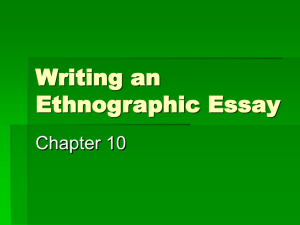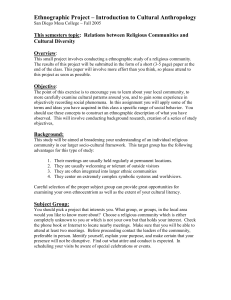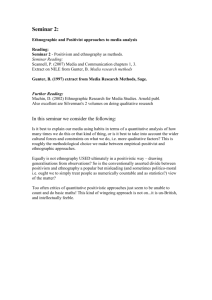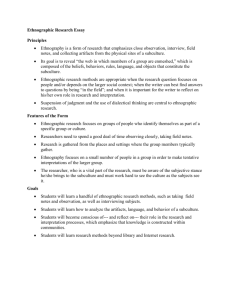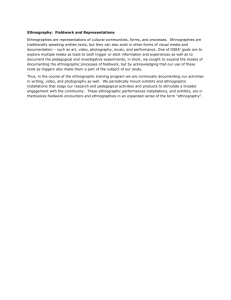United States Department of the Interior
advertisement
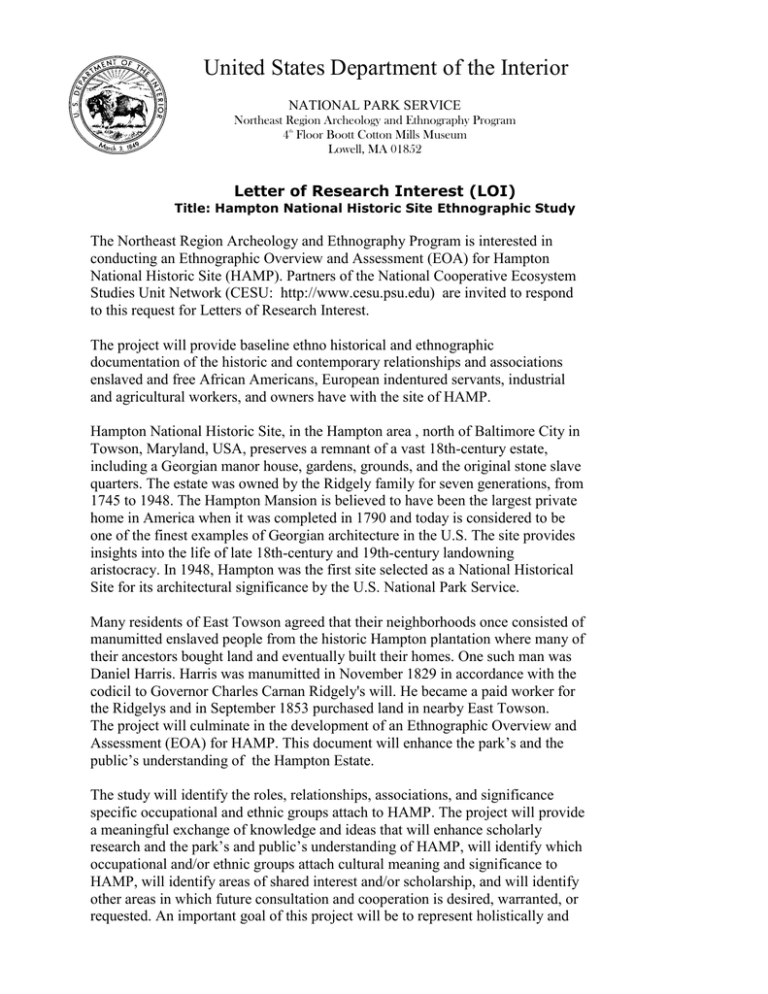
United States Department of the Interior NATIONAL PARK SERVICE Northeast Region Archeology and Ethnography Program 4 Floor Boott Cotton Mills Museum Lowell, MA 01852 th Letter of Research Interest (LOI) Title: Hampton National Historic Site Ethnographic Study The Northeast Region Archeology and Ethnography Program is interested in conducting an Ethnographic Overview and Assessment (EOA) for Hampton National Historic Site (HAMP). Partners of the National Cooperative Ecosystem Studies Unit Network (CESU: http://www.cesu.psu.edu) are invited to respond to this request for Letters of Research Interest. The project will provide baseline ethno historical and ethnographic documentation of the historic and contemporary relationships and associations enslaved and free African Americans, European indentured servants, industrial and agricultural workers, and owners have with the site of HAMP. Hampton National Historic Site, in the Hampton area , north of Baltimore City in Towson, Maryland, USA, preserves a remnant of a vast 18th-century estate, including a Georgian manor house, gardens, grounds, and the original stone slave quarters. The estate was owned by the Ridgely family for seven generations, from 1745 to 1948. The Hampton Mansion is believed to have been the largest private home in America when it was completed in 1790 and today is considered to be one of the finest examples of Georgian architecture in the U.S. The site provides insights into the life of late 18th-century and 19th-century landowning aristocracy. In 1948, Hampton was the first site selected as a National Historical Site for its architectural significance by the U.S. National Park Service. Many residents of East Towson agreed that their neighborhoods once consisted of manumitted enslaved people from the historic Hampton plantation where many of their ancestors bought land and eventually built their homes. One such man was Daniel Harris. Harris was manumitted in November 1829 in accordance with the codicil to Governor Charles Carnan Ridgely's will. He became a paid worker for the Ridgelys and in September 1853 purchased land in nearby East Towson. The project will culminate in the development of an Ethnographic Overview and Assessment (EOA) for HAMP. This document will enhance the park’s and the public’s understanding of the Hampton Estate. The study will identify the roles, relationships, associations, and significance specific occupational and ethnic groups attach to HAMP. The project will provide a meaningful exchange of knowledge and ideas that will enhance scholarly research and the park’s and public’s understanding of HAMP, will identify which occupational and/or ethnic groups attach cultural meaning and significance to HAMP, will identify areas of shared interest and/or scholarship, and will identify other areas in which future consultation and cooperation is desired, warranted, or requested. An important goal of this project will be to represent holistically and with objectivity the legacy of Hampton Estate on enslaved, indentured, and other occupational individuals and/or groups. The Northeast Region (NER) Ethnography Program acting on behalf of HAMP is seeking a partner to aid in identifying and understanding historic and contemporary associations of people with HAMP. The partner will be tasked with completing an ethnographic study that will document the historic relationship and contemporary values and beliefs these people have regarding HAMP. The Ethnographic Overview and Assessment will review existing information on park resources traditionally valued by stakeholders. It will attempt to identify park resources such as landscapes and objects, that are important to a people's sense of purpose and provide an overview of major themes regarding culture and lifestyle and their implications for HAMP resource managers. Information for the completion of the EOA will come mostly from archives and publications and will be supplemented by interviews with community members and other constituents. This will involve trips to specific sites to supply any missing ethnographic data. The study will also identify areas for future research and collaboration. The EOA study is one of many undertaken by the National Park Service to inventory the wide range of resources (natural, historic, archeological, ethnographic) that are found on park lands. Results of studies like these are fully considered in resource management plans, park interpretive or educational programs, and in the day-today operations of parks. Nature of Work Required NER Ethnography Program envisions the project will: 1) Provide a meaningful exchange of knowledge and ideas that will enhance scholarly research and the park’s and public’s understanding of the enslaved population, indentured servants, and other workers who supported the functioning of the Hampton Estate, 2) will identify which of these constituents attach cultural meaning and/or significance to HAMP, 3) will identify areas of shared interest or scholarship, and 4) will identify other areas in which future consultation and cooperation is desired, warranted, or requested. NER Ethnography Program is looking for a partner that can conduct an ethnographic study of HAMP. Responses to this LOI should briefly identify the specific capabilities within the CESU partner institution that will allow them to address the needs of the project, including identification of the relevant departments, faculty, students, and resources that will be involved in the project. Response to this LOI should also briefly outline their approach to the project. A proposed budget is not required at this time. NER Ethnography Program’s substantial involvement with the project will include: providing the cooperator previously collected ethnohistorical and ethnographic studies; coordinating and consulting the findings with the appropriate park units, the State Historic Preservation Offices (SHPO), and Tribal Historic Preservation Offices (THPO); assisting the cooperator in locating and determining park and jurisdictional boundaries; and aiding the cooperator in producing a report on the project that meets the Secretary of the Interior’s standards. Project Timeframe Deadline for responding to this letter of interest is May 23, 2016. Requirements The research will be directed and overseen by a Principal Investigator (PI). The PI should be an applied cultural anthropologist with a Ph.D., or with demonstrable and comparable research. The researcher must demonstrate significant involvement in the research, writing, and the timely completion of ethnographic research. Products The products from this project will include a report documenting the ethnographic study. Funds Available Project funds available are $90,000 that includes the CESU overhead rate of 17.5 percent. The project will be funded by the National Park Service. Only nonfederal partners within the national CESU network are eligible to apply. Letters of Interest Letters of Interest (LOI) should be sent to the addresses located in the “contact” section. LOI’s will be reviewed by a panel. The panel will select the top candidate(s) who will be asked to provide and submit a full proposal detailing the work to be done, providing and describing the methodology and research design, and outlining a schedule of deliverables. The LOI should describe your research interest(s) in the projects, past projects that are similar in topic and/or form, and any relevant experience in completing ethnographic projects. Please include your name, affiliated organization(s), and contact information. Please try and limit LOI’s to 2 pages. Contact Responses of interest should be directed before the closing date to Erik Kreusch (Erik_S_Kreusch@nps.gov). Additional questions can be answered by contacting Erik Kreusch , Cultural Anthropologist, Northeast Region Ethnography Program, National Park Service (978-970-5144).
